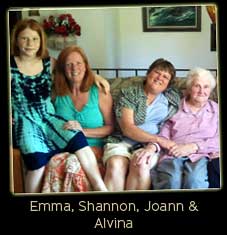Shannon Frizzell, Adult Adoptee and Educator, writes about her parent’s house — first as a receiving home for infants and later as a foster home.

I believe in the adage, “the more the merrier”. I didn’t adopt this manifesto, it adopted me. At full count (but not all at one time), I was raised with 234 brothers and sisters. In addition, Lutheran ladies arrived each afternoon to sip Sanka laced with tablespoons of Cremora while their children played pickup games of softball with my current assembly of brothers and sisters. Forty years later, switch the Sanka to sauvignon blanc, softball to Scrabble and my home captures that same drop-in spirit. The assembly of children has been shuffled into my classroom. A crowded house like a crowded classroom can quickly go bacchanal if the line between merriment and anarchy is not properly maintained. My mother and father taught me how to manage that line but more importantly how to merrily adjust it to accommodate a few more.
My mother wanted to stay at home with her two young children. She possessed few skills beyond housekeeping. Rather than go out of the home to find a job, my mother turned the house into a receiving home for newborns who stayed until they were adopted. During those first weeks, the infants were required to meet benchmarks of psychological tests in order to be placed in a forever family. My parents received a total of sixty-eight babies, caring for up to four infants at a time. Of those sixty-eight, at least two did not meet the psychological benchmark for adoption: me and my sister Joann. My parents chose to adopt us rather than give us up to the alternative. To this day, I’m not sure what the alternative would have been. In our house, we learned not to worry about the could-have-beens and the should-have-beens. We just set another place at the table.
Not all of the babies were healthy. When for the second time, my mother had to summon the pastor to perform a posthumous baptism; she made the decision to foster older children.
This next cycle of children came in all sizes, colors and attitudes—big kids, little kids, white kids, black kids, disabled kids. We were a scene from Dr. Seuss’ Dog Party. My parents adopted a few more children. Seven of us were the constants. The other three available slots were filled in by rotation. The kids would come and go: some came in handcuffs, some slipped away with a backpack into the dark night, some happily returned to their birth families. I liked not having to do the dishes every night and inheriting the occasional cool hand-me-down. My favorite foster siblings were the unwed mothers. I knew their approximate exit date which was better than coming home from school to find we were down a sibling.
My father handled the crew of children with an egalitarian albeit factory approach. During the infant years, he worked the swing shift and his second shift began when he got home. Babies were fed, burped, changed and swaddled before morning, whether they needed it or not. Later on, while we were vacationing in San Francisco with the older children, I remember waiting in line to have him lift each of us up and onto a cable car. As a petulant teen, I longed for youthful parents who drove a four door sedan and who turned us loose on the world. Instead, my now gray-haired parents transported us in a mobile home and then had us proceed in single file to every event.
My daughter is only ten but already she has become impatient with the constant gathering of people in our home. How do I tell her that I do not know how to merrily exclude anyone? The best I can do is maintain that line between merry and madness.
My parents had professional boundaries. Boundaries I learned how to utilize. My mom was a birth mother by biology, an adoptive mother by choice, a foster mother by vocation. Her crowded house, filled with an eclectic collection of children, thrived with her ability to establish a relationship with each of us. The foster kids were her vocation, we were her family, and she knew the difference. For my father, his democratically compulsive approach to raising kids helps me keep it all equitable with my own children and other people’s children. I know that lining up single file means everyone gets to ride the cable car. My parents’ lessons provide the basics in my approach to teaching. I provide a nurturing environment while maintaining a teacher’s perspective.
Maybe my daughter will teach me how to de-clutter my house of people. I doubt it, though. More likely, she will learn, like her mother and grandmother before her, how to hold the line. As long as the kids promise to eat the Popsicles outside, I will buy the valuepak and I will always share it with the mindset, the more the merrier.
Shannon Frizzell teaches Language Arts and History in the Seattle. Washington Public School system. She and her husband Peter Krystad have two children: Conor and Emma. Her mother Alvina recently celebrated her 97th birthday.
Read More from Adoptees: ACE: Adult Adoptee Support Group, A Poem Written a 12 Year Old Adoptee, A Young Adoptee Takes a Journey Back to Adoption STAR, Christian Eshelman Writes about Growing up in a Trans-racial Family, Using Social Media for a Birth Family Search
